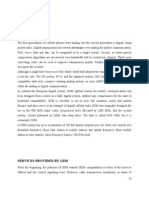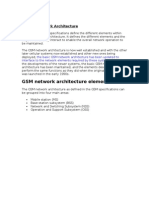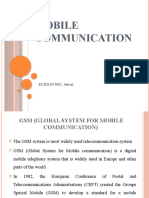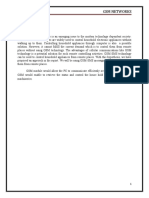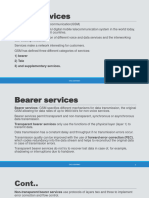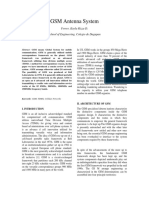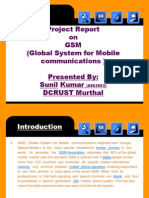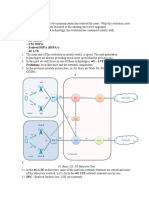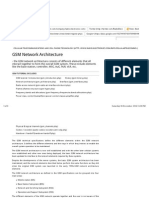Unit-4 (Wireless Communication)
Unit-4 (Wireless Communication)
Uploaded by
Anonymous EjQbY1CCopyright:
Available Formats
Unit-4 (Wireless Communication)
Unit-4 (Wireless Communication)
Uploaded by
Anonymous EjQbY1COriginal Title
Copyright
Available Formats
Share this document
Did you find this document useful?
Is this content inappropriate?
Copyright:
Available Formats
Unit-4 (Wireless Communication)
Unit-4 (Wireless Communication)
Uploaded by
Anonymous EjQbY1CCopyright:
Available Formats
UNIT - IV
GSM (Global System for Mobile communication)
GSM (Global System for Mobile communication) is a digital mobile telephony system that is
widely used in Europe and other parts of the world. GSM uses a variation of time division
multiple access (TDMA) and is the most widely used of the three digital wireless telephony
technologies (TDMA, GSM, and CDMA). GSM digitizes and compresses data, then sends it
down a channel with two other streams of user data, each in its own time slot. It operates at
either the 900 MHz or 1800 MHz frequency band.
Mobile services based on GSM technology were first launched in Finland in 1991. Today,
more than 690 mobile networks provide GSM services across 213 countries and GSM
represents 82.4% of all global mobile connections. According to GSM World, there are now
more than 2 billion GSM phone users worldwide. GSM World references China as "the largest
single GSM market, with more than 370 million users, followed by Russia with 145 million,
India with 83 million and the USA with 78 million users."
Since many GSM network operators have roaming agreements with foreign operators,
users can often continue to use their mobile phones when they travel to other
countries. SIM cards (Subscriber Identity Module) holding home network access
configurations may be switched to those will metered local access, significantly
reducing roaming costs while experiencing no reductions in service.
GSM, together with other technologies, is part of the evolution of wireless mobile
telemmunications that includes High-Speed Circuit-Switched Data (HSCSD), General
Packet Radio System (GPRS), Enhanced Data GSM Environment (EDGE), and Universal
Mobile Telecommunications Service (UMTS).
SERVICES AND FEATURES OF GSM
GSM services are classified as either teleservices or data services. Teleservices include
standard mobile telephony and mobile-originated traffic. Data services include computer to
computer communication and packet switched traffic. User services may be divided into
three major categories.
A. Telephone services: These include emergency calling and facsimile. GSM also
supports Videotext and Teletex.
B. Bearer services or data services: These are limited to layer 1,2 and 3 of the open
system interconnection (OSI) reference model. Supported services include packet switched
protocols and data rates from 300bps to 9.6 kbps. Data may be transmitted using
transparent or non transparent mode.
PINKU MAURYA B.TECH (E&C.E) ~ 1 ~
C. Supplementary ISDN services: these are digital in nature and include call diversion,
closed user groups and caller identification, and are not available in analog mobile
networks. Supplementary services also include short messaging service (SMS) which
allows GSM subscribers and base station to transmit alphanumeric pages of limited length
while simultaneously carrying normal voice traffic. SMS provides cell broadcast also can be
used for safety and advisory applications such as the broadcast of highway or weather
information to all GSM subscribers.
The features of GSM are:
A. Subscriber Identity Module (SIM):
It is a memory device that stores information such as subscribers identification
number. The networks and countries where the subscriber is entitled to service,
privacy keys and other user specific information.
A subscriber uses SIM with four digit personal ID number to activate service from
any GSM phone.
SIM is available as smart card or plug in module, which is less convenient than the
SIM card but is removable and portable.
Without SIM installed all GSM mobiles are identical and non operational. SIM gives
GSM subscriber units their identity.
Subscriber can plug their SIM into any suitable terminal such as a hotel phone,
public phone , or any portable or mobile and are then able to have all incoming GSM
calls routed to that terminal and have all outgoing calls billed to their home phone no
matter where they are in the world.
B. On the air privacy:
Unlike analog FM cellular phone system which can be readily monitored, it is virtually
impossible to eavesdrop on a GSM radio transmission.
The privacy is made possible by encrypting the digital bit stream sent by a GSM
transmitter, according to a specific secret cryptographic key that is known only to the
cellular carrier. This key changes with time for each user.
Every carrier and GSM equipment manufacturer has to sign an international
agreement MoU which allows the sharing of cryptographic algorithms and other
proprietary information between countries and carriers.
GSM network architecture
The GSM technical specifications define the different elements within the GSM network architecture. It
defines the different elements and the ways in which they interact to enable the overall system operation
to be maintained.
The GSM network architecture is now well established and with the other later cellular systems now
established and other new ones being deployed, the basic GSM network architecture has been updated
to interface to the network elements required by these systems.
Despite the developments of the newer systems, the basic GSM system architecture has been
maintained, and the network elements described below perform the same functions as they did when the
original GSM system was launched in the early 1990s.GSM network architecture elements
The GSM network architecture as defined in the GSM specifications can be grouped into four main
areas:
PINKU MAURYA B.TECH (E&C.E) ~ 2 ~
Mobile station (MS)
Base-Station Subsystem (BSS)
Network and Switching Subsystem (NSS)
Operation and Support Subsystem (OSS)
The different elements of the GSM network operate together and the user is not aware of the different
entities within the system.
A basic diagram of the overall GSM system architecture with these four major elements is shown below:
Simplified GSM Network Architecture Diagram
Mobile station
Mobile stations (MS), mobile equipment (ME) or as they are most widely known, cell or mobile phones
are the section of a GSM cellular network that the user sees and operates. In recent years their size has
fallen dramatically while the level of functionality has greatly increased. A further advantage is that the
time between charges has significantly increased.
There are a number of elements to the cell phone, although the two main elements are the main
hardware and the SIM.
The hardware itself contains the main elements of the mobile phone including the display, case, battery,
and the electronics used to generate the signal, and process the data receiver and to be transmitted. It
also contains a number known as the International Mobile Equipment Identity (IMEI). This is installed in
the phone at manufacture and "cannot" be changed. It is accessed by the network during registration to
check whether the equipment has been reported as stolen.
The SIM or Subscriber Identity Module contains the information that provides the identity of the user to
the network. It contains are variety of information including a number known as the International Mobile
Subscriber Identity (IMSI).
Base Station Subsystem (BSS)
PINKU MAURYA B.TECH (E&C.E) ~ 3 ~
The Base Station Subsystem (BSS) section of the GSM network architecture that is fundamentally
associated with communicating with the mobiles on the network. It consists of two elements:
Base Transceiver Station (BTS): The BTS used in a GSM network comprises the radio
transmitter receivers, and their associated antennas that transmit and receive to directly
communicate with the mobiles. The BTS is the defining element for each cell. The BTS
communicates with the mobiles and the interface between the two is known as the Um interface
with its associated protocols.
Base Station Controller (BSC): The BSC forms the next stage back into the GSM network. It
controls a group of BTSs, and is often co-located with one of the BTSs in its group. It manages
the radio resources and controls items such as handover within the group of BTSs, allocates
channels and the like. It communicates with the BTSs over what is termed the Abis interface.
Network Switching Subsystem (NSS)
The GSM system architecture contains a variety of different elements, and is often termed the core
network. It provides the main control and interfacing for the whole mobile network. The major elements
within the core network include:
Mobile Services Switching Centre (MSC): The main element within the core network area of
the overall GSM network architecture is the Mobile switching Services Centre (MSC). The MSC
acts like a normal switching node within a PSTN or ISDN, but also provides additional
functionality to enable the requirements of a mobile user to be supported. These include
registration, authentication, call location, inter-MSC handovers and call routing to a mobile
subscriber. It also provides an interface to the PSTN so that calls can be routed from the mobile
network to a phone connected to a landline. Interfaces to other MSCs are provided to enable
calls to be made to mobiles on different networks.
Home Location Register (HLR): This database contains all the administrative information
about each subscriber along with their last known location. In this way, the GSM network is able
to route calls to the relevant base station for the MS. When a user switches on their phone, the
phone registers with the network and from this it is possible to determine which BTS it
communicates with so that incoming calls can be routed appropriately. Even when the phone is
not active (but switched on) it re-registers periodically to ensure that the network (HLR) is aware
of its latest position. There is one HLR per network, although it may be distributed across various
sub-centres to for operational reasons.
Visitor Location Register (VLR): This contains selected information from the HLR that enables
the selected services for the individual subscriber to be provided. The VLR can be implemented
as a separate entity, but it is commonly realised as an integral part of the MSC, rather than a
separate entity. In this way access is made faster and more convenient.
Equipment Identity Register (EIR): The EIR is the entity that decides whether a given mobile
equipment may be allowed onto the network. Each mobile equipment has a number known as
the International Mobile Equipment Identity. This number, as mentioned above, is installed in the
equipment and is checked by the network during registration. Dependent upon the information
held in the EIR, the mobile may be allocated one of three states - allowed onto the network,
barred access, or monitored in case its problems.
Authentication Centre (AuC): The AuC is a protected database that contains the secret key
also contained in the user's SIM card. It is used for authentication and for ciphering on the radio
channel.
Gateway Mobile Switching Centre (GMSC): The GMSC is the point to which a ME terminating
call is initially routed, without any knowledge of the MS's location. The GMSC is thus in charge of
obtaining the MSRN (Mobile Station Roaming Number) from the HLR based on the MSISDN
(Mobile Station ISDN number, the "directory number" of a MS) and routing the call to the correct
PINKU MAURYA B.TECH (E&C.E) ~ 4 ~
visited MSC. The "MSC" part of the term GMSC is misleading, since the gateway operation does
not require any linking to an MSC.
SMS Gateway (SMS-G): The SMS-G or SMS gateway is the term that is used to collectively
describe the two Short Message Services Gateways defined in the GSM standards. The two
gateways handle messages directed in different directions. The SMS-GMSC (Short Message
Service Gateway Mobile Switching Centre) is for short messages being sent to an ME. The SMS-
IWMSC (Short Message Service Inter-Working Mobile Switching Centre) is used for short
messages originated with a mobile on that network. The SMS-GMSC role is similar to that of the
GMSC, whereas the SMS-IWMSC provides a fixed access point to the Short Message Service
Centre.
Operation and Support Subsystem (OSS)
The OSS or operation support subsystem is an element within the overall GSM network architecture that
is connected to components of the NSS and the BSC. It is used to control and monitor the overall GSM
network and it is also used to control the traffic load of the BSS. It must be noted that as the number of
BS increases with the scaling of the subscriber population some of the maintenance tasks are
transferred to the BTS, allowing savings in the cost of ownership of the system.
RADIO SUB SYSTEM TYPES
As suggested by the name, the radio subsystem is comprised of all the radio specific elements,
i.e. the mobile stations (MS) and the base station subsystem (BSS). The connection between
the RSS and the NSS (shown in figure x.ii) via the A interface (solid lines) and the connection to
the OSS via the O interface (dashed lines). The A interface is generally based on a circuit-
switched PCM-30 system (2.048 Mbit/s), carrying up to 30 X 64 kbit/s connections, whereas the
O interface uses the Signalling System No. 7 (SS7) based on X.25 carrying system management
data to/from the RSS.
Base Station Subsystem (BSS): A GSM network is made up of many BSSs, each one being
controlled by a base station controller (BSC). The main function of the BSS is to maintain the
radio connections to an MS, however, it does have several other functions such as the
coding/decoding of voice, and rate adaptation to/from the wireless network part. As well as a
BSC, the BSS contains several BTSs.
Base Transceiver Station (BTS): A BTS contains all the radio equipment (antennas, signal
processing, amplifiers) necessary for radio transmission. A BTS can be used to form a radio cell,
or if sectored antennas are used, several cells. The BTS is connected to the MS by the Um
interface, and the BSC by the Abis interface. The Um interface comprises of all the mechanisms
necessary for wireless transmission (TDMA, FDMA). Abis interface consists of 16 or 64 kbit/s
connections. The area coverage from a GSM cell can vary from 100m and 35km depending on
the expected traffic and the location environment.
Base Station Controller (BSC): Basically, the BSC controls the BTS The functions of the BSC
include reserving radio frequencies, handling handovers from one BTS to another and
performing the paging of the MS. The BSC also multiplexes the radio channels onto the fixed
network connections at the A interface.
Function BTS BSC
Management of radio channels X
Frequency hopping X X
Management of terrestrial channels X
Mapping of terrestrial onto radio X
PINKU MAURYA B.TECH (E&C.E) ~ 5 ~
channels
Channel coding and decoding X
Rate adaptation X
Encryption/decryption X X
Paging X X
Uplink Signal measurement X
Traffic measurement X
Authentication X
Location registry, location update X
Handover management X
Mobile Station (MS) : The MS is the user equipment which contains the software required for
communication with the GSM network. The MS consists of user independent hard/software and
the subscriber identity module (SIM), which stores the user specific data. While an MS can be
identified via the international mobile equipment identity (IMEI)
FRAM STRACTURE
The GSM system has a defined GSM frame structure to enable the orderly passage of information. The
GSM frame structure establishes schedules for the predetermined use of timeslots.
By establishing these schedules by the use of a frame structure, both the mobile and the base station
are able to communicate not only the voice data, but also signalling information without the various types
of data becoming intermixed and both ends of the transmission knowing exactly what types of
information are being transmitted.
The GSM frame structure provides the basis for the various physical channels used within GSM, and
accordingly it is at the heart of the overall system.
Basic GSM frame structure
The basic element in the GSM frame structure is the frame itself. This comprises the eight slots, each
used for different users within the TDMA system. As mentioned in another page of the tutorial, the slots
for transmission and reception for a given mobile are offset in time so that the mobile does not transmit
and receive at the same time.
Eight slot GSM frame structure
The basic GSM frame defines the structure upon which all the timing and structure of the GSM
messaging and signalling is based. The fundamental unit of time is called a burst period and it lasts for
approximately 0.577 ms (15/26 ms). Eight of these burst periods are grouped into what is known as a
PINKU MAURYA B.TECH (E&C.E) ~ 6 ~
TDMA frame. This lasts for approximately 4.615 ms (i.e.120/26 ms) and it forms the basic unit for the
definition of logical channels. One physical channel is one burst period allocated in each TDMA frame.
In simplified terms the base station transmits two types of channel, namely traffic and control.
Accordingly the channel structure is organised into two different types of frame, one for the traffic on the
main traffic carrier frequency, and the other for the control on the beacon frequency.
GSM multi frame
The GSM frames are grouped together to form multi frames and in this way it is possible to establish a
time schedule for their operation and the network can be synchronised.
There are several GSM multi frame structures:
Traffic multi frame: The Traffic Channel frames are organised into multi frames consisting of
26 bursts and taking 120 ms. In a traffic multi frame, 24 bursts are used for traffic. These are
numbered 0 to 11 and 13 to 24. One of the remaining bursts is then used to accommodate the
SACCH, the remaining frame remaining free. The actual position used alternates between
position 12 and 25.
Control multi frame: the Control Channel multi frame that comprises 51 bursts and occupies
235.4 ms. This always occurs on the beacon frequency in time slot zero and it may also occur
within slots 2, 4 and 6 of the beacon frequency as well. This multi frame is subdivided into logical
channels which are time-scheduled. These logical channels and functions include the following:
o Frequency correction burst
o Synchronisation burst
o Broadcast channel (BCH)
o Paging and Access Grant Channel (PACCH)
o Stand Alone Dedicated Control Channel (SDCCH)
GSM Super frame
Multiframes are then constructed into super frames taking 6.12 seconds. These consist of 51 traffic
multiframes or 26 control multiframes. As the traffic multiframes are 26 bursts long and the control
multiframes are 51 bursts long, the different number of traffic and control multiframes within the
superframe, brings them back into line again taking exactly the same interval.
GSM Hyper frame
Above this 2048 superframes (i.e. 2 to the power 11) are grouped to form one hyper frame which repeats
every 3 hours 28 minutes 53.76 seconds. It is the largest time interval within the GSM frame structure.
Within the GSM hyperframe there is a counter and every time slot has a unique sequential number
comprising the frame number and time slot number. This is used to maintain synchronisation of the
different scheduled operations with the GSM frame structure. These include functions such as:
Frequency hopping: Frequency hopping is a feature that is optional within the GSM system. It
can help reduce interference and fading issues, but for it to work, the transmitter and receiver
must be synchronised so they hop to the same frequencies at the same time.
Encryption: The encryption process is synchronised over the GSM hyper frame period where a
counter is used and the encryption process will repeat with each hyper frame. However, it is
unlikely that the cell phone conversation will be over 3 hours and accordingly it is unlikely that
security will be compromised as a result.
PINKU MAURYA B.TECH (E&C.E) ~ 7 ~
GSM Frame Structure
CDMA DIGITAL CELLULAR STANDARD (IS-95)
It is a 2G mobile telecommunications standard that uses CDMA, a multiple access scheme for digital
radio, to send voice, data and signalling data (such as a dialled telephone number) between
mobile telephones and cell sites.
CDMA or "code division multiple access" is a digital radio system that transmits streams of bits (PN
codes). CDMA permits several radios to share the same frequencies. Unlike TDMA "time division
multiple access", a competing system used in 2G GSM, all radios can be active all the time, because
network capacity does not directly limit the number of active radios. Since larger numbers of phones can
be served by smaller numbers of cell-sites, CDMA-based standards have a significant economic
advantage over TDMA-based standards,[ or the oldest cellular standards that used frequency-division
multiplexing.
The proprietary name for IS-95 is cdmaOne. It is a 2Gmobile telecommunications standard that
usesCDMA, a multiple access scheme for digital radio, to send voice, data and signalling data
(such as a dialled telephone number) between mobile telephones and cell sites
FREQUENCY AND CHANNEL SPECIFICATION
1. IS-95 reverse link frequency band is 824-849MHz and forward link frequency band is
869-894MHz.
2. A PCS version of IS-95 has designed for international use in the 1800-2000MHz
band
3. A forward and reverse channel pair is separated by 45MHz for cellular band
operation. Many users share a common channel for transmission. The maximum
user data rate is 9.6kbps.User data in IS-95 is spread to a channel chip rate of
1.2288Mcps using a combination of techniques. This spreading process is different
for forward and reverse links.
PINKU MAURYA B.TECH (E&C.E) ~ 8 ~
4. On the forward link the user data stream is encoded using a rate Convolutional
code, interleaved and spread by one of 64 orthogonal spreading sequences. Each
mobile in a given cell is assigned a different spreading sequence providing a perfect
separation among the signals from the different users. To reduce interference
between the mobiles that use the same spreading sequence in different cells all
signals in a particular cell are scrambled using a pseudorandom sequence.
5. Orthogonally among all forward channel users within a cell is preserved because
their signals are scrambled synchronously. A pilot channel is provided on the forward
link so that each subscriber within the cell can determine and react to the channel
characteristics.
6. On the reverse link a different spreading strategy is used since each received signal
arrives at base station via different propagation path. The reverse channel user data
stream is first convolutionally encoded with a rate 1/3 code. After interleaving each
block of 6 encoded symbols is mapped to one of the 64 orthogonal Walsh functions
providing 64-ary orthogonal signalling. A final fourfold spreading giving a rate of
1.2288Mcps is achieved by spreading the resulting 307.2kcps stream by user
specific and base station specific codes.
7. The rate of 1/3 coding and mapping onto Walsh functions result in a greater
tolerance for interference. This added robustness is important on the reverse link due
to the non-coherent and the in-cell interference received at the base station.
8. Another essential element of reverse link is tight control of each subscribers
transmitter power to avoid the near-far problem that arises from varying received
power of the users. Open and close loop power control is used to adjust transmitted
power. Power controls are sent at a rate of 800 bps.
9. At both base station and subscriber RAKE receivers are used to resolve and
combine the multipath component thus reducing the degree of fading.
Parameter Data Rate (bps)
User data rate 9600 4800 2400
Coding Rate 1/2
User Data Repetition Period 1 2 4
Baseband Coded Data Rate 19200 19200 19200
PINKU MAURYA B.TECH (E&C.E) ~ 9 ~
Parameter Data Rate (bps)
PN Chips/coded Data Rate 64 64 64
PN Chips Rate (Mcps) 1.2288 1.2288 1.2288
PN Chip/Bit 128 256 512
Table: IS-95 forward traffic Channel Modulation Parameters.
FORWARD CDMA CHANNEL
CDMA forward link uses same frequency spectrum as AMPS i.e. 869-894 MHzs
One channel bandwidth is 1.25 MHz
Modulation scheme used is QPSK.
Orthogonal Walsh codes are used. Walsh codes are called Hadamard codes and
they are used in all CDMA techniques.
Forward channels are separated from each other using different spreading codes. 64
Walsh codes are used to identify each channel.
Type of forward channel:
A. Pilot channel:
PINKU MAURYA B.TECH (E&C.E) ~ 10 ~
It provides phase for coherent demodulation, time, signal strength, comparison with
reference signal for determining when to hand off for all mobile stations.
It is used to uniquely identify sectors or cells.
It is 4-6 db stronger than all other channels. It is used to lock onto other channel.
It is obtained using all zero Walsh code i.e. it contains no information except the RF
carrier.
B. Synch channel:
It is used to acquire initial time synchronization.
Synch messages include System ID (SID), Network ID (NID), the offset of the PN
short code and the paging channel data rate.
It broadcasts synch messages to the mobile station and operates at 1200 bps.
It uses Walsh code 32 for spreading.
C. Paging channel:
There are 7 paging channels used to page the mobile station in case of an incoming
call, or to carry the control messages for call set up.
It uses Walsh code 1-7. There is no power control.
It is additionally scrambled by PN long code, which is generated by LFSR of length
42.
It operates at the rate of 4.8 kbps or 9.6 kbps.
D. Traffic channel:
There are 55 traffic channels used to carry actual information.
It supports variable data rates-RS1={9.6. 4.8, 2.4, 1.2 kbps} and RS2={14.4, 7.2, 3.6,
1.8 kbps}
RS1 is mandatory for IS-95. But support for RS2 is optional.
It also carries power control bits for the reverse channel.
The forward channel modulation process is as follows:
PINKU MAURYA B.TECH (E&C.E) ~ 11 ~
A. Convolution encoder and repetition:
Speech coded voice or user data is encoded using rate convolution encoder with
constraint length 9.
The speech coder exploits gaps and pauses in speech and reduces its output from
9600 bps to 1200 bps during silent period.
Whenever the user data rate is less than 9600 bps each bit is repeated to maintain a
constant symbol rate of 19.2 kbps.
B. Block interleaver:
It makes data block of 20 ms in a random way i.e. consecutive bits are not in a same
block.
It maps the data bits in a 24 by 16 matrix and then transmit it column wise.
This procedure is helpful in recovering the data back if a block is lost during channel
transmission.
C. Long PN sequence:
In forward CDMA channel Direct Sequence is used for data scrambling.
Long PN sequence is user specific code of period 24212421 chips.
PN sequence is generated from a 42 bit code also called as the public mask.
Public mask is specified as- M41 through M32 is set to 1100011000 and M31
through M0 is set to mobile station ESN bits. ESN= (E31, E30, E29, E28, ...... , E1,
E0), permuted ESN= (E0, E31, E22, E13, E14, E26, E17, E8, ...... , E18, E9)
D. Data scrambler:
It is performed after block interleaver. The 1.2288 MHz PN sequence is applied to
decimator which keeps only the first chip out of every 64 consecutive PN chips.
PINKU MAURYA B.TECH (E&C.E) ~ 12 ~
The data rate from the decimator is 19.2 ksps. The data scrambling is performed by
modulo-2 addition of the interleaver output with the decimator output symbol.
E. Power control sub channel:
Power control measures are sent by base station every 1.25ms. Power control
commands are sent to raise or lower its transmission power in 1 db steps.
If the received signal is low 0 is sent over power control sub channel instructing the
mobile station to increase its mean output power level. If mobiles power level is high
1 is sent to indicate that the mobile station should decrease the power level.
F. Orthogonal covering:
Orthogonal scrambling is performed following the data scrambling on the forward
link.
Each traffic channel is transmitted on the forward CDMA channel is spread with a
Walsh function at fixed rate of 1.2288 Mcps.
The Walsh functions consist of 64 binary sequences each of length 64 which are
completely orthogonal to each other and provide orthogonal channelization.
After orthogonal covering Quadrature modulation is performed.
REVERSE CDMA CHANNEL
1. CDMA reverse channel uses frequency band of 869-894 MHz,
2. Bandwidth of each channel is 1.25 MHz. The reverse link is separated from forward
link by 45 MHz.
3. There is no spreading of the data symbols using orthogonal codes instead
orthogonal codes are used for waveform encoding.
4. Spreading is carried out by 42 bit long PN codes. After spreading they are further
scrambled in phase and Quadrature phase by PN spreading codes.
5. Modulation scheme used is OQPSK.
1. There are two types of reverse channels:
PINKU MAURYA B.TECH (E&C.E) ~ 13 ~
A. Access channels:
o It is a random access channel with each channel uniquely identified by their
long codes
o There are 32 access channels per reverse channel. It works at fixed data rate
of 4800 bps.
o It allows a mobile to communicate with the system for registration call
origination.
B. Reverse traffic channel:
o It carries traffic from the mobile station to the base station.
o It operates on variable data rates.
2. The reverse channel modulation process is as follows:
Convolution encoder and symbol repetition:
The convolution encoder used is rate 1/3 and constraint length 9.
The coder bits after convolution encoder are repeated before interleaving when the
data rate is less than 9600 bps.
After symbol repetition the symbol rate out of the coder is fixed at 28800 bps.
PINKU MAURYA B.TECH (E&C.E) ~ 14 ~
A. Block interleaver:
Block interleaving is performed following convolution encoding and repetition.
The block interleaver spans 20 ms and is an array with 32 rows and 18 columns.
The code symbols are written into matrix by columns and read out by rows.
B. Orthogonal modulation:
A 64-ary orthogonal modulation is for the reverse CDMA channel.
One of 64 Walsh functions is transmitted for each group of six coded bits. Within a
Walsh function 64 Walsh chips are transmitted at the rate of 307.2 kbps. 28.8 kbps *
(64 Walsh chips)/ (6 coded bits) = 307.2 kbps
C. Variable data rate transmission:
Variable rate data is sent over CDMA reverse channel.
Data in each 20 ms frame is divided into 16 power control groups, each with 1.25ms.
Some are gated-on some are gated-off.
The data randomizer ensures that every repeated code symbol is transmitted exactly
once.
The data burst randomizer generates a masking pattern of 0s and 1s that randomly
masks the redundant data generated by code repetition process.
For the data rates is 9600 bps, 4800 bps, 2400 bps and 1200 bps transmission
occurs on all 16, 8, 4, 2 power control groups respectively.
D. Direct sequence spreading:
The reverse traffic channel is spread by the long code PN sequence which operates
at the rate of 1.2288 Mcps.
Each Walsh chip is spread by 4 long code PN chips.
E. Quadrature modulation:
Prior to transmission, the reverse channel is spread by I and Q channel pilot PN
sequences. Pilot sequences are used for synchronization.
The reverse link modulation is OQPSK. The data spread by the Q pilot PN sequence
is delayed by half a chip with respect to the data spread by I pilot sequence to
improve spectral shaping and synchronization.
PINKU MAURYA B.TECH (E&C.E) ~ 15 ~
You might also like
- GSM System OverviewDocument12 pagesGSM System Overviewvemala vandanaNo ratings yet
- Essential 4G Guide: Learn 4G Wireless In One DayFrom EverandEssential 4G Guide: Learn 4G Wireless In One DayRating: 4.5 out of 5 stars4.5/5 (12)
- Aae 251 Final Design Project Team pm13Document23 pagesAae 251 Final Design Project Team pm13api-278596732No ratings yet
- Cables Passing Through or Over Joists: BS 7671: 2008 Requires A Cable Installed Under A Floor or Above ADocument2 pagesCables Passing Through or Over Joists: BS 7671: 2008 Requires A Cable Installed Under A Floor or Above AMyoZawNo ratings yet
- GSM Network Architecture: GSM (Global System For Mobile)Document5 pagesGSM Network Architecture: GSM (Global System For Mobile)mard gharibNo ratings yet
- Fundamentals of GSMDocument16 pagesFundamentals of GSMKalai SelvanNo ratings yet
- GSM OverviewDocument18 pagesGSM Overviewchandunandamuri8940No ratings yet
- Overview of The GSM CommunicationsDocument18 pagesOverview of The GSM CommunicationsronyiutNo ratings yet
- Chapter 4Document12 pagesChapter 4Nandhini PNo ratings yet
- GSM (Global System For Mobile Communication)Document3 pagesGSM (Global System For Mobile Communication)Pulkit SharmaNo ratings yet
- Overview of The Global System For Mobile CommunicationsDocument25 pagesOverview of The Global System For Mobile Communicationsaytacerd0% (1)
- What Is GSM Technology - Architecture, Circuit Working & Its ApplicationsDocument18 pagesWhat Is GSM Technology - Architecture, Circuit Working & Its ApplicationslovecasanovarNo ratings yet
- Mobile NetworkDocument12 pagesMobile Networkzelalemderbew59No ratings yet
- 3.3) Basics of GSMDocument13 pages3.3) Basics of GSMRobin SinghNo ratings yet
- 1 - Introduction and Motivation: Evolving of Technology To 4G WirelessDocument13 pages1 - Introduction and Motivation: Evolving of Technology To 4G WirelessSalma SwaidanNo ratings yet
- Overview of The Global System For Mobile CommunicationsDocument25 pagesOverview of The Global System For Mobile Communicationszaid_asiaNo ratings yet
- Rappaport GSMDocument18 pagesRappaport GSMUsman100% (1)
- GSM Network ArchitectureDocument35 pagesGSM Network ArchitectureIkobayo AdewaleNo ratings yet
- Overview of The Global System For Mobile CommunicationsDocument25 pagesOverview of The Global System For Mobile CommunicationsLiyang ChangNo ratings yet
- Entities of The GSM SystemDocument18 pagesEntities of The GSM Systemhieuvnp3No ratings yet
- John Scourias: A Brief Overview of GSM, byDocument14 pagesJohn Scourias: A Brief Overview of GSM, bymohsinakram1No ratings yet
- Global System For Mobile (GSM)Document17 pagesGlobal System For Mobile (GSM)Barhav SarbastNo ratings yet
- CC CC CC: C CC CC CC CDocument19 pagesCC CC CC: C CC CC CC Cpk_babuaNo ratings yet
- The GSM System History: NextDocument19 pagesThe GSM System History: NextJoseph DavisNo ratings yet
- Mobile TechnologyDocument18 pagesMobile TechnologyLady BugNo ratings yet
- Global System Mobility (GSM)Document28 pagesGlobal System Mobility (GSM)Zain ABNo ratings yet
- Global System For Mobile CommunicationsDocument4 pagesGlobal System For Mobile CommunicationsSayan HaldarNo ratings yet
- G.S.M Modem/MobileDocument9 pagesG.S.M Modem/MobileJilly ArasuNo ratings yet
- AssignmentDocument14 pagesAssignmentzeeshan783aminNo ratings yet
- Wireless Communication Unit 4Document10 pagesWireless Communication Unit 4Lavanya R GowdaNo ratings yet
- Introduction To GSM: GSM (Global System For Mobile Communications)Document12 pagesIntroduction To GSM: GSM (Global System For Mobile Communications)Anuj KuradeNo ratings yet
- GSM Network ArchitectureDocument5 pagesGSM Network Architecturekataz2010No ratings yet
- Network Switching SubsystemDocument24 pagesNetwork Switching SubsystemAIC DSNo ratings yet
- Finalised GSM OverviewDocument33 pagesFinalised GSM OverviewishanrajdorNo ratings yet
- Chapter 3 v1 DFP6033Document40 pagesChapter 3 v1 DFP6033Vimalan RamanathanNo ratings yet
- 6 GSMDocument19 pages6 GSMGato El GatosNo ratings yet
- Mobile Communication: ECED, SVNIT, SuratDocument97 pagesMobile Communication: ECED, SVNIT, SuratSHUBHAM RANKAWAT SVNITNo ratings yet
- GggsssmmmrreeppoorrttDocument23 pagesGggsssmmmrreeppoorrttakshay099No ratings yet
- WNPPT4Document14 pagesWNPPT4namudajiyaNo ratings yet
- Global System FOR Mobile Communication: A Seminar Report OnDocument10 pagesGlobal System FOR Mobile Communication: A Seminar Report Onkokilla100% (1)
- Forensics and The GSM Mobile Telephone System: International Journal of Digital Evidence Spring 2003, Volume 2, Issue 1Document17 pagesForensics and The GSM Mobile Telephone System: International Journal of Digital Evidence Spring 2003, Volume 2, Issue 1BEALogicNo ratings yet
- Telecommunication: GSM (Global System For Mobile Communication)Document7 pagesTelecommunication: GSM (Global System For Mobile Communication)Simum100% (1)
- GSM Network ArchitectureDocument5 pagesGSM Network ArchitecturePrashant KulkarniNo ratings yet
- CDMA Vs GSMDocument20 pagesCDMA Vs GSMKrati SethNo ratings yet
- Unit 1-Gsm Architecture & InterfacesDocument13 pagesUnit 1-Gsm Architecture & InterfacesJovita Lasrado0% (1)
- GSM Network ArchitectureDocument5 pagesGSM Network Architecturenarayanan07No ratings yet
- GSM in Antenna SystemDocument5 pagesGSM in Antenna SystemKaylaNo ratings yet
- GSM Cellular Network: 1 Principles of GSM Mobile Communication TechnologyDocument17 pagesGSM Cellular Network: 1 Principles of GSM Mobile Communication TechnologyTuan-Anh BuiNo ratings yet
- Unit 2 - Wireless & Mobile Computing - WWW - Rgpvnotes.inDocument17 pagesUnit 2 - Wireless & Mobile Computing - WWW - Rgpvnotes.inprateek bharadwajNo ratings yet
- Overview of The Global System For MobileDocument16 pagesOverview of The Global System For MobilevenkateshmukharjiNo ratings yet
- Project Report On GSM (Global System For Mobile Communications) Presented By: Sunil Kumar DCRUST MurthalDocument21 pagesProject Report On GSM (Global System For Mobile Communications) Presented By: Sunil Kumar DCRUST MurthalRakesh SaberwalNo ratings yet
- Unit-2 MCDocument17 pagesUnit-2 MCJohnpaulNo ratings yet
- MC Unit 2Document32 pagesMC Unit 2akramshaik2004No ratings yet
- What Is IUBDocument17 pagesWhat Is IUBtuyambaze jean claudeNo ratings yet
- GSM Paper Presentation On Frequency PlanningDocument5 pagesGSM Paper Presentation On Frequency PlanningphalanetraNo ratings yet
- Global System For Mobile: Vinay SahuDocument5 pagesGlobal System For Mobile: Vinay SahuVinay SahuNo ratings yet
- Telecom AssignmentDocument5 pagesTelecom Assignmentikra khanNo ratings yet
- GSM Technology: Architecture, Security and Future ChallengesDocument6 pagesGSM Technology: Architecture, Security and Future ChallengesamgreengNo ratings yet
- Archtecture of GSMDocument8 pagesArchtecture of GSMMjrtMQNo ratings yet
- Unit 4 - Mobile Communication - WWW - Rgpvnotes.inDocument9 pagesUnit 4 - Mobile Communication - WWW - Rgpvnotes.inRohit kumarNo ratings yet
- Functions of The Passive VoiceDocument6 pagesFunctions of The Passive VoiceAl HabsiNo ratings yet
- Chemistry Investigatory Project Class 12 - ToothpasteDocument20 pagesChemistry Investigatory Project Class 12 - ToothpasteKishoreNo ratings yet
- Functional Biology NOTESDocument113 pagesFunctional Biology NOTESRebecca Amy JennerNo ratings yet
- Navijet C500eiiiDocument2 pagesNavijet C500eiiiსულხან ზაქარაძეNo ratings yet
- Satellite Pro L300D-SP5801Document4 pagesSatellite Pro L300D-SP5801SPIN2018100% (1)
- LAB - The Axial Skeleton: ObjectivesDocument4 pagesLAB - The Axial Skeleton: ObjectivesSufiyaNo ratings yet
- Webinar - Micro Motion 4200 Coriolis TransmitterDocument19 pagesWebinar - Micro Motion 4200 Coriolis TransmittermedicalbillingspamNo ratings yet
- The Seven Principal of Leave No TraceDocument22 pagesThe Seven Principal of Leave No TraceMadame UrsulaNo ratings yet
- MIT15 450F10 Lec05Document32 pagesMIT15 450F10 Lec05seanwu95No ratings yet
- Arrow AntennaDocument8 pagesArrow AntennaRanne ManuelNo ratings yet
- Assessment of Tunnelling-Induced Building DamageDocument10 pagesAssessment of Tunnelling-Induced Building DamageMarco NevesNo ratings yet
- Manual de Usuario DTMDocument44 pagesManual de Usuario DTMAntonio Chuman MedinaNo ratings yet
- Wien Bridge Oscillator DesignDocument16 pagesWien Bridge Oscillator DesignReece RevosaNo ratings yet
- 430 CNG ZFDocument729 pages430 CNG ZFOlaf Nava100% (1)
- Shelf Life Extension of CheeseDocument18 pagesShelf Life Extension of Cheesenils2484100% (1)
- Hip ExaminationDocument43 pagesHip ExaminationJayakrishnu tjNo ratings yet
- (Buyer's Official Letterhead) : White Refined Cane Sugar Icumsa 45 - Fit For Human ConsumptionDocument3 pages(Buyer's Official Letterhead) : White Refined Cane Sugar Icumsa 45 - Fit For Human ConsumptionKayla WhiteNo ratings yet
- 4 Layers of The EarthDocument3 pages4 Layers of The EarthAngelica Maeriz MindoroNo ratings yet
- Design of AD Fixed Dome Reactor For A Vegetable MarketDocument3 pagesDesign of AD Fixed Dome Reactor For A Vegetable MarketAlexis ChicaizaNo ratings yet
- BV Module B H20R 07493 E0 ECDocument3 pagesBV Module B H20R 07493 E0 ECPhilSelborNo ratings yet
- Techniques and Indices For Preventive Maintenance OptimizationDocument6 pagesTechniques and Indices For Preventive Maintenance OptimizationGopi SubramaniamNo ratings yet
- Sartorius Gem Extend ManualDocument60 pagesSartorius Gem Extend Manualagoes diantoroNo ratings yet
- I. Personal Information: Foto 3x4Document4 pagesI. Personal Information: Foto 3x4rizmahNo ratings yet
- Fire Fighting AppliancesDocument10 pagesFire Fighting AppliancesLynton MenezesNo ratings yet
- Periodontology 2000 - 2021 - Hajishengallis - Polymicrobial Communities in Periodontal Disease Their Quasi OrganismalDocument21 pagesPeriodontology 2000 - 2021 - Hajishengallis - Polymicrobial Communities in Periodontal Disease Their Quasi Organismalalan.da.s.aguirreNo ratings yet
- Burton Connor History PDFDocument68 pagesBurton Connor History PDFKatie ChenNo ratings yet
- Secret Language of AttractionDocument288 pagesSecret Language of AttractiontrongkienckvNo ratings yet
- Fire and Explosion PDFDocument96 pagesFire and Explosion PDFanpuselvi125100% (1)













